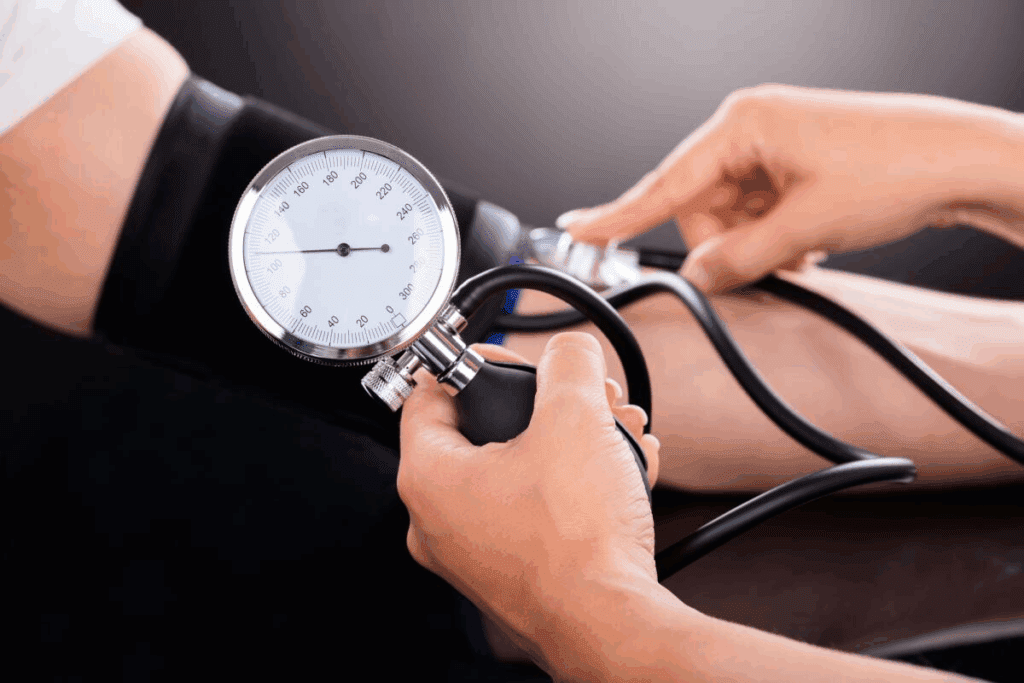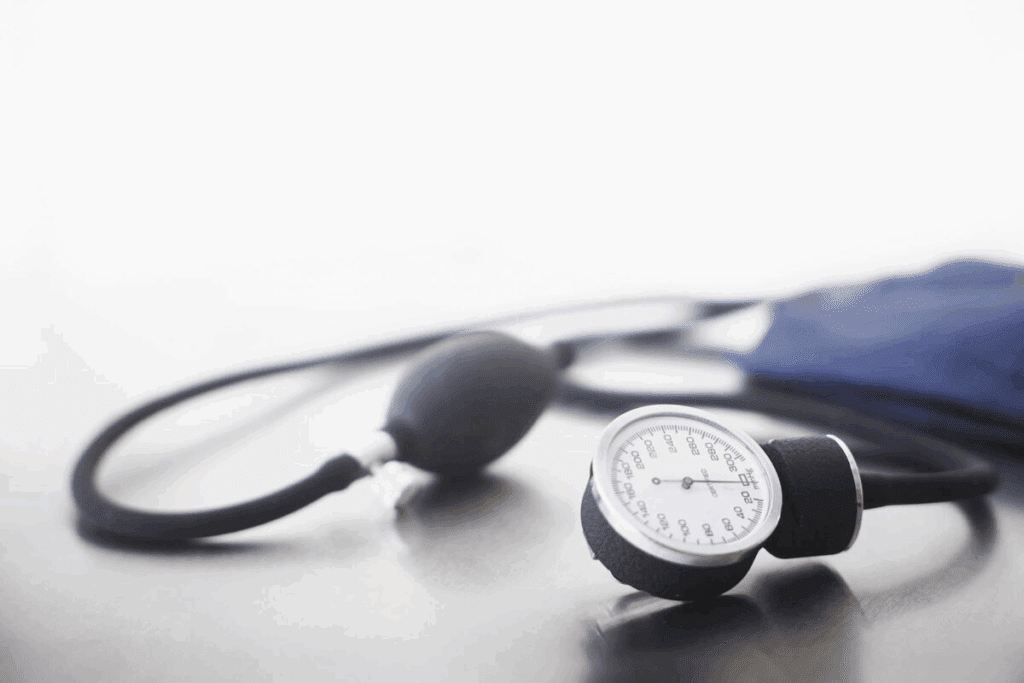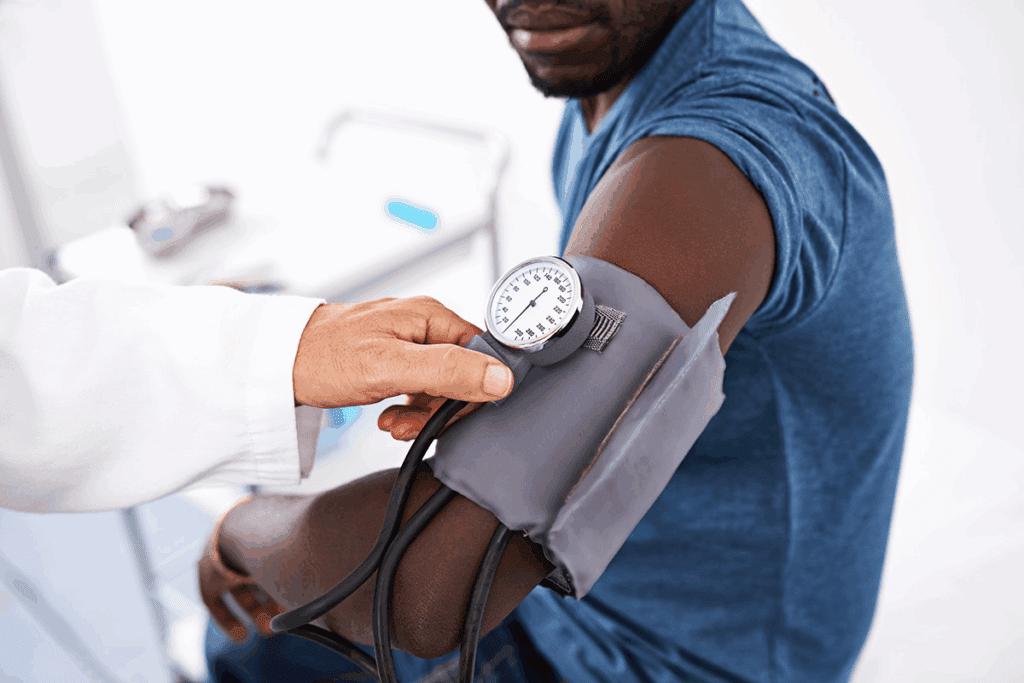
High blood pressure, or hypertension, is often called the “silent killer.” It usually doesn’t show symptoms until it’s very serious. It’s vital to know your blood pressure and check it often to avoid serious health issues.
Understand high bp symptoms and how to recognize dangerously high readings.
At Liv Hospital, we stress the need to recognize the subtle signs of elevated blood pressure. While high bp symptoms are rare, knowing them can save your life. By monitoring regularly and understanding these signs, you can manage your blood pressure better.

High blood pressure is called the “silent killer” because it often doesn’t show symptoms until it’s too late. It’s a condition where blood pressure is too high, which can harm your heart, brain, and kidneys. This can lead to serious health problems.
High blood pressure is when your blood pressure is always over 130/80 mmHg. It can develop over time due to genetics, diet, lifestyle, and age. Understanding what high blood pressure is is the first step in managing it.
Normal blood pressure is below 120/80 mmHg. High blood pressure can damage your blood vessels, heart, and other organs. It’s important to check your blood pressure regularly to catch it early.
Hypertension is a big health problem worldwide. The Centers for Disease Control and Prevention (CDC) says nearly half of adults in the U.S. have it. The prevalence increases with age, and it’s more common in some ethnic groups.
High blood pressure often doesn’t show symptoms for years. This makes it hard to detect without regular checks. Regular monitoring is key to catching it early.
Some people might feel headaches or dizziness, but these aren’t always signs. It’s important to get your blood pressure checked regularly, even if you don’t feel sick.

It’s important to know the signs of high blood pressure early. Many people with high blood pressure don’t show symptoms. But, some may notice certain signs that suggest their blood pressure is too high.
Early morning headaches can be a sign of high blood pressure. These headaches happen because of the pressure on blood vessels in the brain at night. If you often wake up with headaches, check your blood pressure.
Dizziness and lightheadedness might mean your blood pressure is high. These feelings happen when blood vessels are affected, causing less blood to reach the brain. If you feel dizzy often, see a doctor.
Blurred vision and visual disturbances can also be signs of high blood pressure. The high pressure can harm the blood vessels in your eyes, causing vision problems. If your vision changes, get your blood pressure checked.
Shortness of breath can be a sign of high blood pressure, along with chest pain or fatigue. It means your heart is working harder to pump blood. If not treated, it could lead to heart failure.
| Symptom | Description | Potential Cause |
| Early Morning Headaches | Headaches occurring in the early morning | Increased pressure on blood vessels in the brain |
| Dizziness and Lightheadedness | Sensations of dizziness or feeling faint | Reduced blood flow to the brain |
| Blurred Vision and Visual Disturbances | Changes in vision, including blurriness | Damage to blood vessels in the eyes |
| Shortness of Breath | Difficulty breathing | Increased strain on the heart |
Knowing these symptoms can help you spot blood pressure issues early. Regular checks and talks with doctors are key to managing high blood pressure well.
Knowing the lesser-known symptoms of high blood pressure is key for early treatment. While headaches and dizziness are common, other signs can also point to hypertension.
High blood pressure can cause confusion or changes in how you think. This happens because the pressure on blood vessels in the brain goes up. It can lead to worse thinking skills or even hypertensive crisis in bad cases.
Some people might find it hard to focus or have memory problems. If you or someone you know is feeling this way, seeing a doctor is important. They can check if high blood pressure is the cause.
Facial flushing, or a sudden face redness, can be a sign of high blood pressure. This happens because the body’s blood vessels get wider. More blood flows to the skin’s surface.
Facial flushing can have many causes. But if it keeps happening without a clear reason, like being very hot or stressed, getting your blood pressure checked is a good idea.
Blood in the urine, or hematuria, can mean severe hypertension. High blood pressure can hurt the kidneys and their blood vessels. This can cause bleeding.
If you see blood in your urine, you need to see a doctor right away. It could be a sign of a serious problem.
An irregular heartbeat, or arrhythmia, can be linked to high blood pressure. The heart’s rhythm can change because of the pressure. This might feel like your heart is skipping beats or racing.
Watching your heart rhythm and telling your doctor about any odd feelings can help catch hypertension early.
| Symptom | Description | Potential Cause |
| Confusion/Cognitive Changes | Difficulty concentrating, memory issues | Increased pressure on brain blood vessels |
| Facial Flushing | Sudden reddening of the face | Dilated blood vessels |
| Blood in Urine | Hematuria | Kidney damage due to high BP |
| Irregular Heartbeat | Arrhythmia, palpitations | Increased pressure on the heart |
It’s important to know these extra warning signs for high blood pressure. If you’re experiencing any of these symptoms, talk to a healthcare professional. They can help figure out what’s best for you.
The only way to know if your blood pressure is high is to measure it. High blood pressure, or hypertension, often doesn’t show symptoms until it has caused a lot of damage. So, it’s important to check your blood pressure regularly for early detection and management.
Checking your blood pressure often is key to catching hypertension early. Early detection lets you act fast, which can stop serious problems like heart disease, stroke, and kidney damage. If you’re over 18, check your blood pressure at least once every two years. If you’re at higher risk, do it more often.
Measuring your blood pressure at home is easy and can give a true picture of your levels all day. To get accurate readings, follow these steps:
Blood pressure is measured in millimeters of mercury (mmHg) and shown as two numbers: systolic (top number) and diastolic (bottom number). Knowing these numbers is important for managing your blood pressure.
| Blood Pressure Category | Systolic (mmHg) | Diastolic (mmHg) |
| Normal | Less than 120 | Less than 80 |
| Elevated | 120-129 | Less than 80 |
| Hypertension Stage 1 | 130-139 | 80-89 |
Keeping a record of your blood pressure readings helps you and your healthcare provider see changes over time. Consistency is key for effective monitoring.
By learning how to measure and understand your blood pressure, you’re taking a big step towards managing your health. Regular monitoring and a healthy lifestyle can help keep your blood pressure at the right level.
Many people wonder if they can feel their blood pressure. But, high blood pressure often doesn’t show obvious signs. This can lead to late diagnosis and treatment, making it important to know the signs.
Some think you can “feel” when your blood pressure is high. But, this is not usually true. Most people with high blood pressure don’t feel symptoms until it’s very bad.
Studies show most people with high blood pressure don’t show symptoms. This is why it’s so dangerous, as it can quietly harm organs and blood vessels.
There are reasons why high blood pressure symptoms are often missed. One reason is that the body can get used to the higher pressure. Also, symptoms can be vague and blamed on other things.
While many with high blood pressure don’t feel symptoms, some do. The symptoms can vary a lot from person to person.
To understand symptoms better, let’s look at common ones reported by people with high blood pressure:
| Symptom | Frequency | Commonality |
| Headaches | Occasional | Common |
| Dizziness | Frequent | Moderate |
| Shortness of Breath | Rare | Less Common |
Studies show men and women experience high blood pressure symptoms differently. Knowing these differences helps doctors give better care.
Women often report headaches and dizziness, while men might feel more general symptoms. This helps doctors tailor treatment plans for each patient.
Understanding high blood pressure symptoms helps people manage their condition better. This can lower the risk of serious problems.
A hypertensive crisis is a serious medical issue that needs quick help. Knowing the signs is key to getting the right care fast. We’ll cover the important symptoms and what to do if you see them.
Hypertensive urgency means very high blood pressure without organ damage. Look out for severe headache, shortness of breath, and nosebleeds. If you have these and high blood pressure, get medical help right away.
A hypertensive emergency is worse, with high blood pressure harming organs like the heart, brain, or kidneys. Watch for chest pain, severe headache with confusion and blurred vision, nausea and vomiting, severe anxiety, shortness of breath, seizures, and even loss of consciousness. If you see these signs, act fast.
If your blood pressure is over 180/120 mm Hg and you have symptoms like chest pain, shortness of breath, or severe headache, call 911. Quick medical care is vital to avoid serious problems or death.
When you get to the emergency room, doctors will quickly check you and start treatment. They might give you medicine to lower your blood pressure and handle symptoms. Tell them everything about your health and any medicines you’re taking.
Understanding how serious a hypertensive crisis is and when to get emergency care is very important. Knowing the symptoms and acting fast can help prevent serious health issues.
High blood pressure comes from many risk factors. Some we can’t change, but others we can manage. Knowing these factors helps us spot who’s at risk and take steps to prevent it.
Some risk factors for high blood pressure can’t be changed. Family history is a big one; if your family has hypertension, you might too. As we get older, our risk of high blood pressure goes up. Studies show that after 40, the risk of hypertension increases a lot.
Our genes also play a part in how our bodies handle blood pressure. We can’t change our genes, but knowing this can make us more careful about our health.
Our lifestyle choices also affect our risk for high blood pressure. Eating too much salt, saturated fats, and cholesterol can raise blood pressure. The American Heart Association suggests eating less than 2,300 milligrams of sodium a day.
Not being active is another big risk factor. Exercise helps lower blood pressure and keeps our hearts healthy. Smoking and drinking too much alcohol can also harm our blood vessels and raise blood pressure.
“The number one risk factor for whether you will develop hypertension is your family history of hypertension or high blood pressure.” This shows how important it is to know your family’s health history and talk about it with your doctor.
Understanding both non-modifiable and lifestyle-related risk factors helps us manage our blood pressure. We can make better choices and work with doctors to keep our risk factors in check.
Diagnosing high blood pressure is more than just noticing symptoms. It needs a detailed medical check-up. Doctors use your medical history, physical exam, and tests to find out if you have hypertension.
The first step in diagnosing high blood pressure is talking about your health and doing a physical exam. Your doctor will ask about your family’s health, your lifestyle, and any symptoms. They will also check for signs of high blood pressure complications.
Diagnosing blood pressure isn’t just one reading. Doctors take many readings to confirm hypertension. There are different ways to measure blood pressure, including:
Your doctor might also order more tests to check your condition. These can include:
After your tests, your doctor will explain your diagnosis and what it means for your health. Knowing your blood pressure numbers and the stage of your hypertension is key to managing it. Your doctor will help you create a treatment plan that fits your needs.
To control high blood pressure, a mix of lifestyle changes and medical treatments is needed. This approach includes daily habits, medication, and regular check-ups. It’s a complete strategy for managing hypertension.
Changing your lifestyle is key to managing high blood pressure. Eating a healthy diet with lots of fruits, veggies, and whole grains is important. Also, cut down on sodium and alcohol.
Regular physical activity like walking can also help. Keeping a healthy weight and managing stress through meditation or deep breathing are also beneficial. Quitting smoking is essential for your heart health.
If lifestyle changes aren’t enough, medication might be needed. There are many types of blood pressure medicines, like diuretics and ACE inhibitors. The right one depends on your health and needs.
It’s important to work with your doctor to find the best medicine and dosage. Taking your medicine as directed is key to managing your blood pressure.
Keeping an eye on your blood pressure is vital. This can be done through home blood pressure monitoring and doctor visits. Keeping a blood pressure log helps track progress and patterns.
It’s also important to watch for any side effects of your medicine. Regular health checks help ensure your heart is doing well.
If your blood pressure isn’t getting better, it might be time to make changes. This could mean switching medicines, adjusting dosages, or changing your lifestyle. Talking regularly with your doctor is important for making these decisions.
Knowing the signs of a hypertensive crisis is also critical. If you see these signs, get help right away. It could save your life.
We’ve looked at the signs and symptoms of high blood pressure. It’s key to be aware and check your blood pressure often. Managing high blood pressure well means taking action for your health.
It’s important to get your blood pressure checked regularly, even if you don’t feel sick. Knowing your blood pressure numbers helps you work with your doctor. This way, you can manage your condition better.
Controlling your blood pressure means making smart choices about your life and treatment. We urge you to stay updated, check your condition often, and get medical help when needed. This keeps your blood pressure in check and improves your health overall.
By managing your blood pressure, you lower the risks of serious health problems. It’s a journey, and we’re here to support you. We want to help you take charge of your blood pressure health.
High blood pressure often doesn’t show symptoms. So, it’s key to check it regularly. This is even more important if you have a family history or other risk factors.
Some symptoms include early morning headaches, dizziness, blurred vision, or shortness of breath. But, many people with high blood pressure don’t show any symptoms. This is why regular check-ups are so important.
Usually, you can’t feel when your blood pressure is high. It’s often called a “silent killer” because it can harm you without you noticing.
High blood pressure can feel different for everyone. Some people might not feel anything at all. Others might feel facial flushing, confusion, or an irregular heartbeat in severe cases.
It’s hard to tell without a monitor. We suggest not relying on symptoms alone. Instead, use a validated blood pressure device for regular checks.
Warning signs include severe headache, chest pain, severe dizziness, or confusion. If you or someone you know has these symptoms, get help right away.
Diagnosing high blood pressure involves taking multiple readings at different times. Your doctor might also do more tests to check your heart health.
Changes like a balanced diet, regular exercise, stress reduction, and less sodium can help. Your doctor can give you specific advice.
Yes, there are many medications for high blood pressure. The right one and dosage depend on your health and how severe your hypertension is.
If you have hypertension, check your blood pressure as often as your doctor says. This could be every day, week, or at another interval based on your treatment plan.
World Health Organization. (2025). 7 Warning Signs and Symptoms of High BP. Retrieved from https://www.who.int/news-room/fact-sheets/detail/hypertension
Subscribe to our e-newsletter to stay informed about the latest innovations in the world of health and exclusive offers!
WhatsApp us